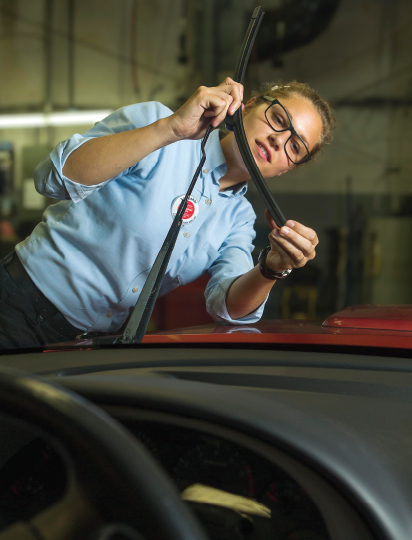Save time and money by getting to know your vehicle
Knowledge is power, especially when it comes to cars.
Getting to know your vehicle can save you time, money and a few headaches, say local car care experts.
“If you are not familiar with your car, then everything seems abnormal. But if you have a relationship with your car, then you can head off any major problems.” said B.J. Lambdin, who owns Cary Car Care with his father, Paul, and sister, Kelsey.
The folks at Atlantic Tire and Service want to empower drivers as well. Offered at all three area locations, the shop’s popular “ABCs of Car Care” class gives attendees safety tips and money-saving advice while explaining the importance of regular maintenance.
“We give them safe, good and fun information,” said Nancy Seymour, who has led the classes for about four years. “Because we’ve all been there. It’s not like you are born knowing the answers to all these questions.”
Our experts take us through some regular checks, and suggest helpful skills for any car owner — new or experienced. The checks should be performed at regular intervals, once a month or every other month.
If you have more questions about your car, they are happy to help.
“You can always call your mechanic and ask him for advice,” said Kelsey Lambdin. Then B.J. added: “If you are afraid to call, then you need to find another mechanic.”
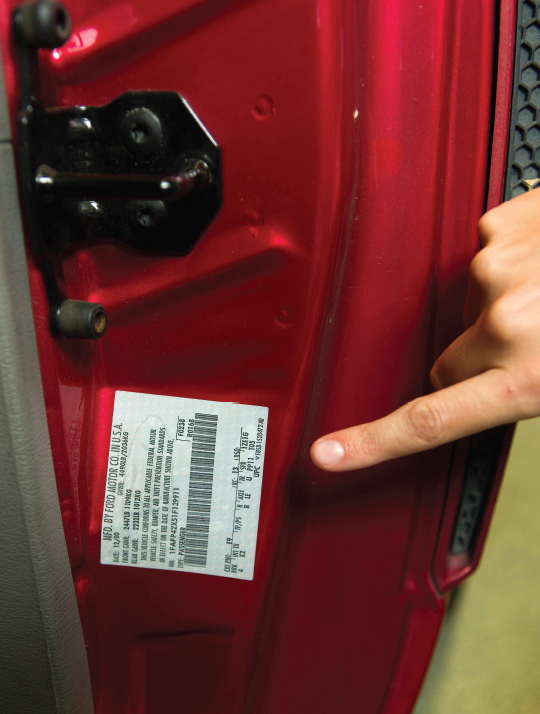
The car’s Vehicle Identification Number is often located on the driver’s side doorjamb. Sometimes you can find the manufacturer’s guidelines about tires there too.
Basic Information
Although most drivers know their vehicle year, make and model, it’s also important to know where to locate the car’s VIN, or Vehicle Identification Number. Most of the time this information is located on the driver’s side doorjamb. Kelsey says knowing the year, make and model helps your mechanic better estimate how much a repair will cost, even without seeing the car. The VIN helps consumers keep track of recalls or repair history.
Owners should also be familiar with the manufacturer’s suggested care schedule, says Seymour. This makes it easier to budget for major maintenance visits.
Kelsey and B.J. also suggest keeping a record of all the work done to your vehicles. Some people use a log book; others keep all their receipts in their glove box. This is especially helpful if you change mechanics or sell your car.
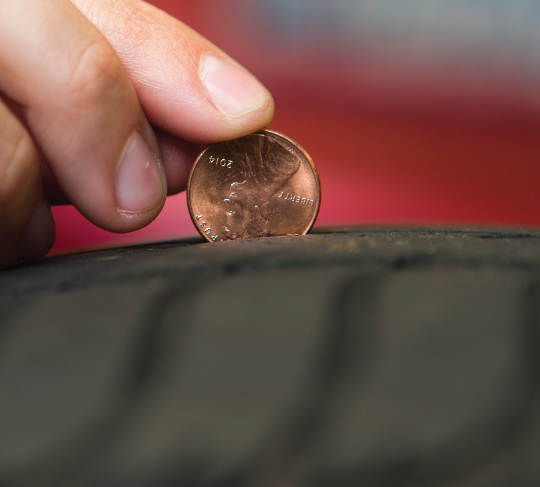
If you can see the top of Abe’s head, your tire needs to be replaced.
Tires
The proper tires, properly maintained, will keep you safe, improve your ride and save you gas.
In most cases, it’s best if the tire’s size, listed on its side, matches the manufacturer’s specifications, says Kelsey. The recommended tires are listed in the vehicle owner’s manual, on the driver’s side doorjamb or glove box lid. The minimum tire pressure should also be listed there. You can find the maximum tire pressure on the sidewall of the tire. For optimal ride and gas mileage, the Lambdins say tire pressure should be somewhere between these two numbers.
Tire pressure should be checked regularly, and always before driving the car, says Seymour. Even a moderate temperature fluctuation can reduce tire pressure.
“More of the tire is on the ground when the air is let out. You’ve got more drag on that tire, which affects your gas mileage, and the tire wears out faster,” she said.
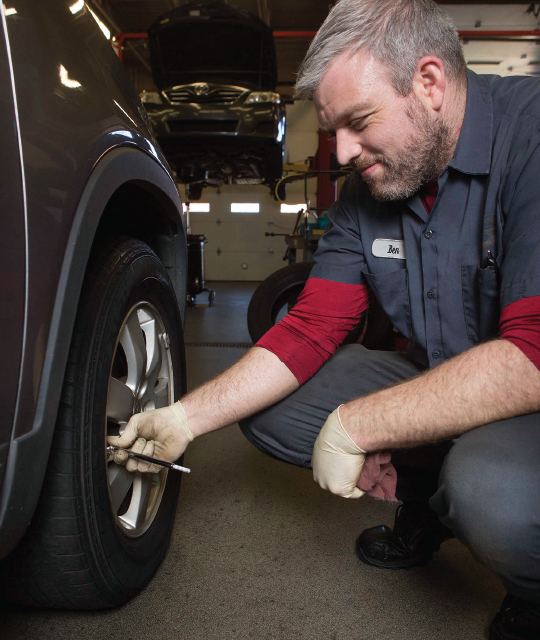
Ben Powell, a general service technician from Atlantic Tire and Service, checks tire pressure.
Don’t forget to check the treads too. All three of our experts stress that tire tread is vital for safety, because the treads disperse water, allowing the tire to grip the road.
“In dry weather, even a bald tire will get you where you are going, but in wet weather, you are at risk of hydroplaning,” said Kelsey.
Check your tires with the upside-down penny trick. If you can see the top of Abe’s head, replace the tire, and do it as soon as you can.
“Tires and tread are the cheapest form of insurance,” said Seymour.
Car Care Class
There isn’t a set schedule for Atlantic Tire and Service’s “ABCs of Car Care” classes as yet. But if you’d like to attend an upcoming session, keep an eye on their Facebook page at facebook.com/atlantictireandservice, or send an email to nseymour@atlantictireonline.com.
Wipers and Lights
Often drivers don’t pay attention to wiper blades until they are streaking or making noise, but it’s important to check them for tears in the rubber and to replace them regularly. Most wiper blades should be replaced annually, but if you park outside, every six months may be better.
“The elements can put a lot of wear and tear on your wipers,” said Kelsey.
All vehicle lights should be inspected regularly. A burned out bulb may mean a trip to the mechanic, but it’s better than discovering you have no headlights on a stormy night.
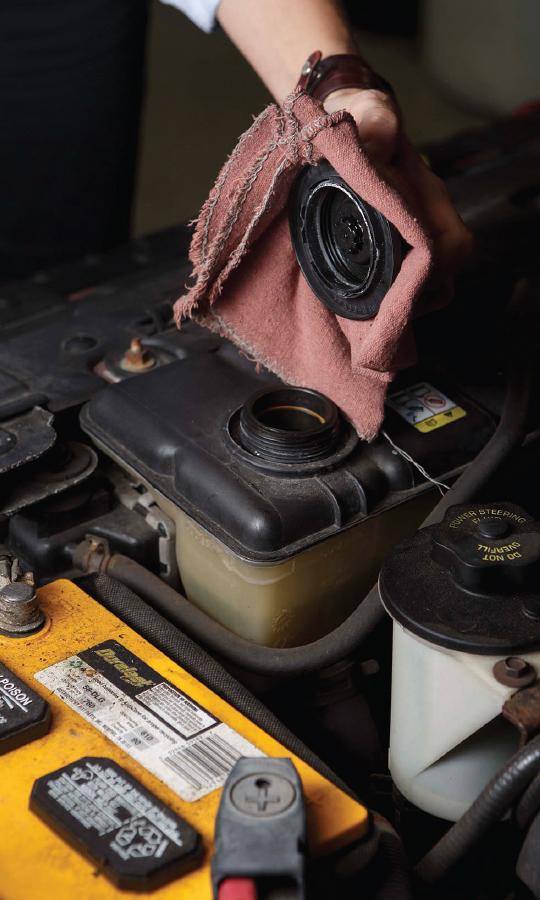
Only check your coolant levels when the engine is cold. Even then, remove the radiator cap slowly, as the contents may be under pressure. “Think soda bottle,” says B.J. Lambdin.
Fluids
Drivers should know how to monitor their car’s fluids, and know what kind of fluid goes where. This information is in the owner’s manual, but most reservoirs are clearly marked. If any fluids are low, and you don’t know why, the Lambdins say to see your mechanic.
- Check oil monthly. Some cars can read up to a quart low, when they are in fact full. To head off problems, it is important to know what is normal for the car.
- Check coolant when engine is cold. If levels are low, distilled water can be added in a pinch. Ideally, antifreeze formulated for the North Carolina climate should be used.
- Windshield washer solution is made to avoid freezing in winter. Top off as needed.
- For power steering, brake and transmission fluids, see mechanic if low.
“If you put the wrong fluid in the wrong reservoir, do not drive,” said B.J. “Call your mechanic as soon as you can, because driving can make things a lot worse.”
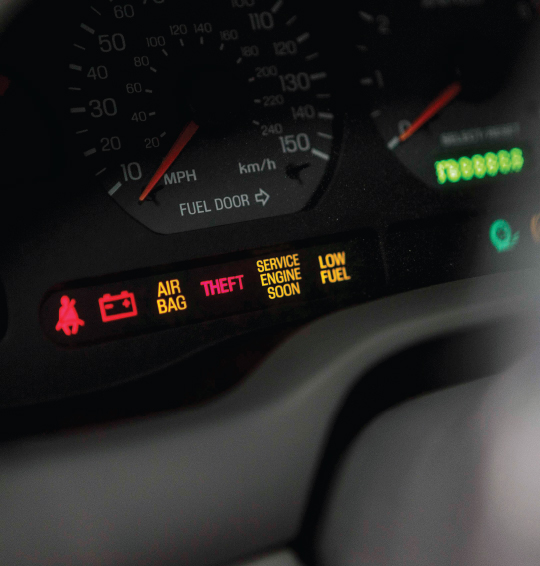
It’s good to know what all your car’s warning lights mean, and especially important to know if it’s safe to continue driving.
Warning Lights
When a warning light comes on, it’s important to know if you can keep cruising or if you need to pull over immediately. Your owner’s manual can give you the rundown on each light, but these are ones to watch.
Service Engine Soon: If flashing, do not drive as this could indicate a damaged catalytic converter.
Coolant: Do not drive; vehicle is overheating. Check levels when safe, and if coolant is low, top off and drive.
Battery: Indicates problem with charging system. Turn off accessories to save power, and get to a safe place to pull over.
Oil Pressure: Check oil level and if low, top it off. If light goes out, it is safe to drive the vehicle. If light stays on, have the car towed to your mechanic.
Jump Starting Basics
Seymour likes the security of having a compact car battery jump starter in her trunk. She asked: “As a woman, do you want to wait for whoever is going to stop? What if it’s at night?”
Better yet, know how to jump-start a battery, Kelsey says. Having jumper cables and a diagram showing how to use them in your car can save you from being stranded. B.J. also suggests keeping a pair of safety goggles and gloves with the jumper cables.
A good rule of thumb is to “go in a big circle,” said Kelsey.
- Starting with the dead battery, clamp one end of the red cable to its positive terminal. The saying “Red to Dead” is a good way to remember where to start.
- Go to the boost battery; attach the other end of the red cable to its positive terminal.
- Still with the boost battery, clamp one end of the black cable to the negative terminal.
- Find a piece of unpainted metal on the engine block of the dead car, and attach the remaining end of the black cable.
- Start the working car and let the engine run for about a minute before starting the impaired car.
- Once both cars are running, disconnect the cables in reverse order: Engine block, negative terminal (black clamp) of boost battery, positive terminal of boost battery, positive terminal of previously dead battery.
- Best Restaurants
- Best Services
- Best Shopping
- Announcing the 2016 MAGGY AWARDS
- Best Lifestyle
- Go Get It: Life advice from our Maggy winners
- Car Care: Tips for Anyone
- 3 Cures for Cabin Fever
- Use Your Imagination
- Dreamfest 2016
- Sweet Wintersweet
- Choice Charities
- Exclusive Dish: The Mason Jar Tavern’s S’more in a Jar
- Restaurant Row: Doherty’s Irish Pub & Restaurant



